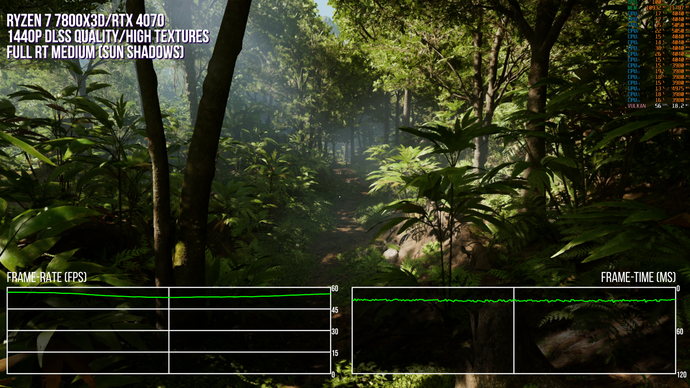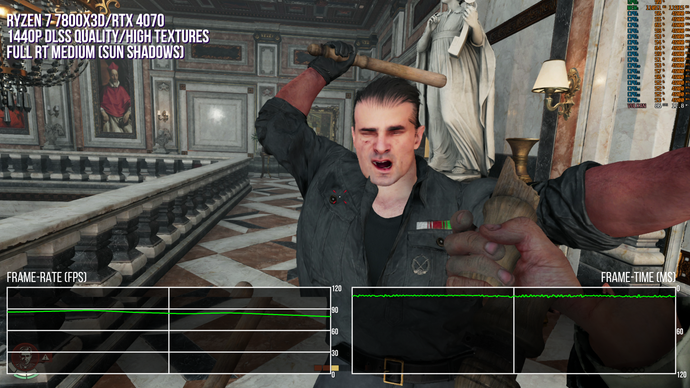Indiana Jones and the Great Circle is shaping up to be one of my favourite games of all time, capturing the look and feel of the classic movies – and its rendering plays a big part in that. The standard game ships with a form of ray-traced global illumination, but Machine Games has gone one step further for the PC version, delivering a full ray tracing upgrade. This turns an already great-looking game into an even better one, often bridging the gap between RTGI and full offline rendering. It has its limitations – which we’ll go into – but overall, it’s a spectacular upgrade. Yes, it can be demanding on hardware, but you can still enjoy the lion’s share of the benefits on RTX 4070-class hardware at 1440p resolution.
The nature of full RT is that it automatically ‘fixes’ a lot of the issues in the standard game renderer and one of the most glaring is its shadows – or more specifically, the cascaded shadow maps cast from the sun or the moon. Moving forward and backward in the game shows big visual discontinuities, flipping between blocky shadow map representations very close to the camera in a highly distracting way. Full RT fixes that, greatly enhancing shadows quality, realism and detail.
The ‘popping’ shadow map cascade problem disappears completely, while also reducing aliased noise in the shadows close up to the player camera, most obviously seen in the jungle sections. Without full RT, shadow maps cannot resolve final detail from the trees, so details pop in and out of existence on each frame. RT shadows present all the detail from the leaves and branches above, with full soft shadow detail and none of the awkward aliasing or popping found in the base game. Also, the basic nature of RT tech ensures you get accurate penumbral effects: shadows close to the casting object are sharp, becoming more diffuse the further away from the object they are.
Small detail also benefits: Indiana Jones and Great Circle has a lot of high quality geometry and often, objects in the game are either excluded from the shadow map pass or they are far too small for the shadow map to resolve correctly or accurately. RT sun shadows, on the other hand, are calculated on a per-pixel basis, giving each and every rivet, blade of grass or little trinket perfectly sharp and accurate self-shadows, capable of dramatically increasing the object’s apparent quality and material look.
Full RT is also transformative on glass rendering. Without it, glass reflections are wholly rendered via static cube maps – basic approximations of the scene, with a very low resolution and often misaligned with the environment, looking ‘wrong’. Full RT option handles reflections, giving all the glass surfaces in the game sharp ray-traced reflections that resolve the issue, rendering the correct visual information in the scene. The world looks a lot more alive in comparison and glass takes on a new sheen, literally. There is not too much glass scattered across Dr Jones’ world-trotting adventure, but it is there often enough for it to be an appreciated upgrade over the base game’s cube maps.
Perhaps the largest upgrade to the visuals comes from the change to indirect lighting, both diffuse and specular. Specular lighting is essentially both glossy and rough reflections and diffuse lighting means the lighting that bounces around a scene, brightening up dark areas. A combination of systems are stripped out and replaced with path-traced indirect lighting which carries out multiple bounces and also has a system for caching results to accumulate even more. The base game’s screen-space reflections, cube maps and a contribution from the RTGI work well enough – but there are obvious limitations. All reflections must be mirror-like, for example, which doesn’t look right on rougher surfaces. Materials can also look much more flat than they should, which you’ll see demonstrated to remarkable effect in my video embedded on this page.
The improvement to material quality can be substantial: polished hardwood floors now look a lot more like the real deal, showcasing very subtle reflections of bright light sources, like the sky. It’s the same with marble, which looked OK at grazing angles, but just didn’t look right when viewed full-on. Full RT’s perspective-correct reflections alleviate that issue completely. The impact to metal rendering in particular can be astonishing: in the standard game, metal surfaces tend to look shallow and dark, so all of the glorious artefacts look dull on inspection. With full RT, metal objects reflect themselves and nearby objects. Brass, silver, and gold look much more visually distinct as opposed to looking very much the same. Multi-bounce reflections from the indirect lighting option really aid the visuals, pushing some more mundane scenes from looking ‘videogamey’ due to the materials being dull, to looking quite spectacular
The differences in diffuse lighting are also transformative. The standard RTGI system is based around a grid of probes that extend from the camera origin. These probes then ‘send out’ ray from the probe’s perspective into the world around it. It’s good enough to create some great results, but it’s not per-pixel in nature like full RT, so it can be prone to light leakage in a variety of ways, while the amount of light bounces is also reduced, impacting fidelity. Again, the video showcases some of these scenarios quite effectively. Turning on the path-tracing, lighting is evaluated on a per-pixel level, cleaning up the errors. The fact that so many more objects are contained within the BVH structure (the geometry being traced against) adds massively to the realism, particularly evident in the more dense scenes like the jungle. Along with looking more natural, it also greatly increases contrast. This is especially apparent if you compare to Xbox Series X, where even fewer objects are traced against than PC – with full RT on, the game looks generationally different in such scenes.
So the game looks a good deal better, but not everything is better as the full RT implementation in Indiana Jones isn’t quite as comprehensive as that seen in Cyberpunk 2077 or Alan Wake 2. It does look better nearly everywhere, but in some areas, the differences are much smaller because there is still some left-over rasterisation in some unexpected areas. Shadows and direct lighting not from the sun are still rasterised and using shadow maps. Indoor areas often exhibit the same shadow map ‘acne’ and issues in the base game. So, shadows ‘pop’ their level of detail quality, light leaks through objects not properly accounted for and there are even non-shadow casting lights. Indiana Jones isn’t using RTXDI or ReSTIR Direct Lighting, so some lighting is still going down the rasterisation path.
Another issue is that bodies of water still use screen-space reflections. There are no RT reflections here, which looks very strange indeed. Then there are some more bizarre issues. Indiana Jones as the player character is seen in reflections, but curiously, his hair is not! And where hair is visible, it just looks wrong – the hair on Indy’s hands, for example, just isn’t presenting correctly. The last oversight is that cloth in the game does not seem to have light permeate it to the other side. This looks like an oversight and not a technical limitation, as the vegetation for the game does show lighting and shadow transmission perfectly with the path tracing on.
It’s also important that DLSS ray reconstruction is added to the game. Right now it’s using Nvidia’s NRD denoiser, which is fine but has issues. Reflections in movement can smear and exhibit lag. Reflections in reflections can be a bit unstable too. This is far from a disaster but I am pretty sure ray reconstruction would do a much better job and may even improve performance. If these negative points here put you off, wait for further patches as I expect they will be addressed.
On the flip side, the concessions made to the full RT implementation result in a ‘lighter’ game than Cyberpunk 2077 and Alan Wake 2. The majority of the b-roll in the video I created uses DLSS quality mode on an RTX 4090 with no frame generation – which simply wouldn’t be possible in, say, Alan Wake 2. The only exception to this is in the jungle area, which is heavier and required me to drop to DLSS performance mode – again, with no frame generation. How does the game scale down? Well, VRAM is an issue so an RTX 4070 with 12GB of memory, the texture cache option will need to drop high or medium to get decent performance. Even with texture cache concessions in place, you still need DLSS performance mode to get good frame-rates – but the hit to quality is too high.


For this class of hardware, I’d be recommending 1440p resolution in DLSS quality mode with the full RT setting on medium. You’ll get RT sun shadows and a boost to the game’s base default RTGI. Above that, the high full RT setting adds in single-bounce RT reflections, which replace SSR and cubemaps with RT reflections, greatly aiding indirect lighting quality and the quality of materials like metals. For a 4070 though, the combination of RT sun shadows and the image quality from DLSS quality mode is still great and will run at 60fps, even in the jungle areas.
One final thing. In our initial coverage, we complained about cutscene animation issues. The latest patch notes suggest it has been fixed, but it’s definitely still there. In numerous cutscenes in the Vatican and thereafter, many of the cinematics played out with many animations still running at 30fps. It still looks pretty bad and definitely needs developer attention.
I’ll level with you: I was disappointed when the early access version of Indiana Jones and the Great Circle failed to ship with full RT features, but it’s here now and I’m highly impressed by the presentation. An already stunning game is further transformed and while the totally uncompromised experience running at 4K resolution is going to require some serious hardware, RT is scalable and it’s still possible to get an elevated experience on more mainstream-level kit like an RTX 4070. There are improvements to be made and issues to fix, but the full RT experience in this game is simply beautiful and I highly recommend checking it out if you have the means.
